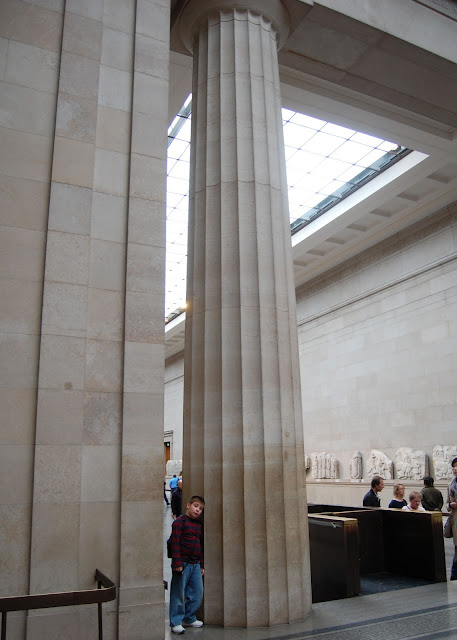The British Museum is in London and is dedicated to human history and culture. It was established in 1753. Some of the items that it houses are of intense controversy, such as the Elgin Marbles from the Parthenon.
I could easily spend two days in this almost religious temple of a place. By the time we left to catch our train we were all exhausted and overwhelmed with all that we'd seen. I had taken hundreds of photos and my mind was swimming with just how many artifacts and collections they have there. It's inspiring to know that this was all created so long ago by what must have been supreme artists working year upon year.
If you ever get the chance, go. It is worth it. It is life changing. You will be amazed.
 |
Exterior of the British Museum
|
 |
| Love the interior of the Museum which was obviously outside at one point but now has this curved triad ceiling of glass that lends a beautiful glow to all beneath it. |
 |
| A copy of the Rosetta Stone that you can touch. |
 |
| Totem poles from British Columbia made of red cedar wood from about 1850. |
 |
| Exquisite detail on this enormous pedestal that looked like an enormous bird bath. |
 |
Easter Island statue
Cult image, made between 11th and
17th centuries. Eighteenth century visitors including Captain Cook
recorded the giant statues still standing, many destroyed. Surviving
examples now re-erected on the island, a World Heritage site. This
statue was collected by British survey ship HMS Topaze in 1868,
presented to Queen Victoria by the lords of the admiralty, and by her to
the museum.
|
 |
| Part of the Egyptian exhibit. It was enormous! |
 |
Head of Rameses
Egyptian, 1270BC. Presented by JL
Burckhardt but taken from its site at Thebes by Giovanni Belzoni, a
circus strongman turned professional antiquities hunter. |
 |
| The actual Rosetta Stone. |
 |
| The Crouching Venus is a Hellenistic model of Venus
surprised at her bath. Venus crouches with her right knee close to the
ground, turns her head to the right and, in most versions, reaches her
right arm over to her left shoulder to cover her breasts.[1] To judge by the number of copies that have been excavated on Roman sites in Italy and France, this variant on Venus seems to have been popular. |
 |
Parthenon marbles
Greek, 5th century BC. Bought from the
Ottoman rulers of Greece, dismantled by Lord Elgin in 1799, and then
recovered from a shipwreck in a hugely expensive operation which left
him deeply in debt. Bought by the government for £35,000 and deposited
'in perpetuity' in the museum in 1816 |
 |
| Add caption |
 |
The Portland Vase
Perhaps from Rome, Italy, about AD 5-25
The most famous cameo-glass vessel from antiquity
|
September 2012









































































No comments:
Post a Comment